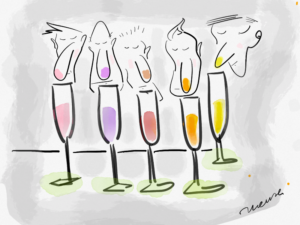
It’s very likely that the first thing you learned about wine, even before you were old enough to have tasted any, is that it comes in two colors, red and white. Like lots of other stories we’re told as children, this one is too simplistic to be either useful or true. But it is, God help us, persistent. Retail merchandising is in thrall to it, as are the wine lists in restaurants and cobwebbed old adages about serving red with meat and white with fish.
I suspect there’s a dissertation to be written on all the cultural ins and outs of the historic red wine/white wine divide. In lieu of that, and in pursuit of a more grownup understanding of what color in wine means or doesn’t, let’s consider just the following.
Complication 1: Wine grapes come in a rainbow of colors, from nearly black to palest yellow-green, but these tints are only skin deep. With rare exception, the juice of every variety of wine grape runs clear. If juice and skins are not given an opportunity to interact, the resulting wine will show little or no color. This is why it’s possible to produce a white wine from red grapes (as is frequently done in Champagne), although it’s impossible to make a red wine from white grapes.
Complication 2: Winemakers fully control whether and how long juice and skins are allowed to enjoy each other’s company — and thus determine how the finished wine will look. Heavily pigmented grapes left in the fermentation tank for weeks or months will produce the deepest colors; lightly pigmented fruit experiencing short macerations (or none at all) will produce the lightest. Thus, color is always a deliberate outcome; a matter of preference or style. Style may be imposed by appellation authorities or by a vintner’s personal vision. But the notion that any wine could be said to possess a natural color is a dubious one.
Complication 3: Wine color has been used to both create and confirm consumer expectations, leveraging the widespread belief that deeply colored red wines are also deeply-flavored and complex; while near-colorless white wines are refreshingly dry, crisp and sippable. Of course, neither of these holds true. Experience leads me to the conclusion that while the visual color of a wine may be meaningful when considered in the context of other similar, quality wines from the same region and vintage, outside these constraints I can’t say that I’ve found color to be a reliable indicator of character, quality or drinkability.
Lastly, who can say precisely where a red wine leaves off and a rosé begins; or a white wine shades, with multiple imperceptible gradations, into something orange or amber?
The kaleidoscopic varieties of color are one of the glories of wine. Let’s embrace them all.